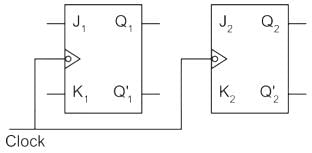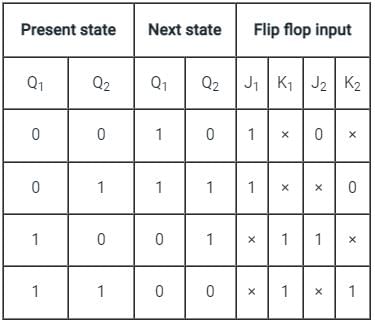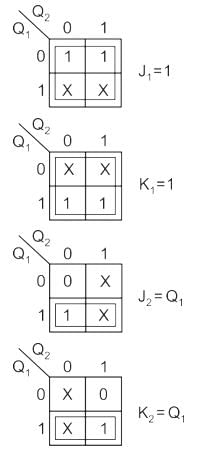Electrical Engineering (EE) Exam > Electrical Engineering (EE) Questions > A synchronous counter using two J – K f...
Start Learning for Free
A synchronous counter using two J – K flip flops that goes through the sequence of states: Q1 Q2 = 00 → 10 → 01 → 11 → 00 …. is required. To achieve this, the inputs to the flip flops are

- a)J1 = Q2, K1 = 0; J2 = Q1’, K2 = Q1
- b)J1 = 1, K1 = 1; J2 = Q1, K2 = Q1
- c)J1 = Q2, K1 = Q2’; J2 = 1, K2 = 1
- d)J1 = Q2’, K1 = Q2; J2 = Q1, K2 = Q1’
Correct answer is option 'B'. Can you explain this answer?
Verified Answer
A synchronous counter using two J – K flip flops that goes throu...
By using excitation table of JK flip flop.

From the above table,

Most Upvoted Answer
A synchronous counter using two J – K flip flops that goes throu...
By using excitation table of JK flip flop.

From the above table,


|
Explore Courses for Electrical Engineering (EE) exam
|

|
Similar Electrical Engineering (EE) Doubts
Question Description
A synchronous counter using two J – K flip flops that goes through the sequence of states: Q1Q2= 00 → 10 → 01 → 11 → 00 …. is required. To achieve this, the inputs to the flip flops area)J1= Q2, K1= 0; J2= Q1’, K2= Q1b)J1= 1, K1= 1; J2= Q1, K2= Q1c)J1= Q2, K1= Q2’; J2= 1, K2= 1d)J1= Q2’, K1= Q2; J2= Q1, K2= Q1’Correct answer is option 'B'. Can you explain this answer? for Electrical Engineering (EE) 2025 is part of Electrical Engineering (EE) preparation. The Question and answers have been prepared according to the Electrical Engineering (EE) exam syllabus. Information about A synchronous counter using two J – K flip flops that goes through the sequence of states: Q1Q2= 00 → 10 → 01 → 11 → 00 …. is required. To achieve this, the inputs to the flip flops area)J1= Q2, K1= 0; J2= Q1’, K2= Q1b)J1= 1, K1= 1; J2= Q1, K2= Q1c)J1= Q2, K1= Q2’; J2= 1, K2= 1d)J1= Q2’, K1= Q2; J2= Q1, K2= Q1’Correct answer is option 'B'. Can you explain this answer? covers all topics & solutions for Electrical Engineering (EE) 2025 Exam. Find important definitions, questions, meanings, examples, exercises and tests below for A synchronous counter using two J – K flip flops that goes through the sequence of states: Q1Q2= 00 → 10 → 01 → 11 → 00 …. is required. To achieve this, the inputs to the flip flops area)J1= Q2, K1= 0; J2= Q1’, K2= Q1b)J1= 1, K1= 1; J2= Q1, K2= Q1c)J1= Q2, K1= Q2’; J2= 1, K2= 1d)J1= Q2’, K1= Q2; J2= Q1, K2= Q1’Correct answer is option 'B'. Can you explain this answer?.
A synchronous counter using two J – K flip flops that goes through the sequence of states: Q1Q2= 00 → 10 → 01 → 11 → 00 …. is required. To achieve this, the inputs to the flip flops area)J1= Q2, K1= 0; J2= Q1’, K2= Q1b)J1= 1, K1= 1; J2= Q1, K2= Q1c)J1= Q2, K1= Q2’; J2= 1, K2= 1d)J1= Q2’, K1= Q2; J2= Q1, K2= Q1’Correct answer is option 'B'. Can you explain this answer? for Electrical Engineering (EE) 2025 is part of Electrical Engineering (EE) preparation. The Question and answers have been prepared according to the Electrical Engineering (EE) exam syllabus. Information about A synchronous counter using two J – K flip flops that goes through the sequence of states: Q1Q2= 00 → 10 → 01 → 11 → 00 …. is required. To achieve this, the inputs to the flip flops area)J1= Q2, K1= 0; J2= Q1’, K2= Q1b)J1= 1, K1= 1; J2= Q1, K2= Q1c)J1= Q2, K1= Q2’; J2= 1, K2= 1d)J1= Q2’, K1= Q2; J2= Q1, K2= Q1’Correct answer is option 'B'. Can you explain this answer? covers all topics & solutions for Electrical Engineering (EE) 2025 Exam. Find important definitions, questions, meanings, examples, exercises and tests below for A synchronous counter using two J – K flip flops that goes through the sequence of states: Q1Q2= 00 → 10 → 01 → 11 → 00 …. is required. To achieve this, the inputs to the flip flops area)J1= Q2, K1= 0; J2= Q1’, K2= Q1b)J1= 1, K1= 1; J2= Q1, K2= Q1c)J1= Q2, K1= Q2’; J2= 1, K2= 1d)J1= Q2’, K1= Q2; J2= Q1, K2= Q1’Correct answer is option 'B'. Can you explain this answer?.
Solutions for A synchronous counter using two J – K flip flops that goes through the sequence of states: Q1Q2= 00 → 10 → 01 → 11 → 00 …. is required. To achieve this, the inputs to the flip flops area)J1= Q2, K1= 0; J2= Q1’, K2= Q1b)J1= 1, K1= 1; J2= Q1, K2= Q1c)J1= Q2, K1= Q2’; J2= 1, K2= 1d)J1= Q2’, K1= Q2; J2= Q1, K2= Q1’Correct answer is option 'B'. Can you explain this answer? in English & in Hindi are available as part of our courses for Electrical Engineering (EE).
Download more important topics, notes, lectures and mock test series for Electrical Engineering (EE) Exam by signing up for free.
Here you can find the meaning of A synchronous counter using two J – K flip flops that goes through the sequence of states: Q1Q2= 00 → 10 → 01 → 11 → 00 …. is required. To achieve this, the inputs to the flip flops area)J1= Q2, K1= 0; J2= Q1’, K2= Q1b)J1= 1, K1= 1; J2= Q1, K2= Q1c)J1= Q2, K1= Q2’; J2= 1, K2= 1d)J1= Q2’, K1= Q2; J2= Q1, K2= Q1’Correct answer is option 'B'. Can you explain this answer? defined & explained in the simplest way possible. Besides giving the explanation of
A synchronous counter using two J – K flip flops that goes through the sequence of states: Q1Q2= 00 → 10 → 01 → 11 → 00 …. is required. To achieve this, the inputs to the flip flops area)J1= Q2, K1= 0; J2= Q1’, K2= Q1b)J1= 1, K1= 1; J2= Q1, K2= Q1c)J1= Q2, K1= Q2’; J2= 1, K2= 1d)J1= Q2’, K1= Q2; J2= Q1, K2= Q1’Correct answer is option 'B'. Can you explain this answer?, a detailed solution for A synchronous counter using two J – K flip flops that goes through the sequence of states: Q1Q2= 00 → 10 → 01 → 11 → 00 …. is required. To achieve this, the inputs to the flip flops area)J1= Q2, K1= 0; J2= Q1’, K2= Q1b)J1= 1, K1= 1; J2= Q1, K2= Q1c)J1= Q2, K1= Q2’; J2= 1, K2= 1d)J1= Q2’, K1= Q2; J2= Q1, K2= Q1’Correct answer is option 'B'. Can you explain this answer? has been provided alongside types of A synchronous counter using two J – K flip flops that goes through the sequence of states: Q1Q2= 00 → 10 → 01 → 11 → 00 …. is required. To achieve this, the inputs to the flip flops area)J1= Q2, K1= 0; J2= Q1’, K2= Q1b)J1= 1, K1= 1; J2= Q1, K2= Q1c)J1= Q2, K1= Q2’; J2= 1, K2= 1d)J1= Q2’, K1= Q2; J2= Q1, K2= Q1’Correct answer is option 'B'. Can you explain this answer? theory, EduRev gives you an
ample number of questions to practice A synchronous counter using two J – K flip flops that goes through the sequence of states: Q1Q2= 00 → 10 → 01 → 11 → 00 …. is required. To achieve this, the inputs to the flip flops area)J1= Q2, K1= 0; J2= Q1’, K2= Q1b)J1= 1, K1= 1; J2= Q1, K2= Q1c)J1= Q2, K1= Q2’; J2= 1, K2= 1d)J1= Q2’, K1= Q2; J2= Q1, K2= Q1’Correct answer is option 'B'. Can you explain this answer? tests, examples and also practice Electrical Engineering (EE) tests.

|
Explore Courses for Electrical Engineering (EE) exam
|

|
Signup to solve all Doubts
Signup to see your scores go up within 7 days! Learn & Practice with 1000+ FREE Notes, Videos & Tests.





















